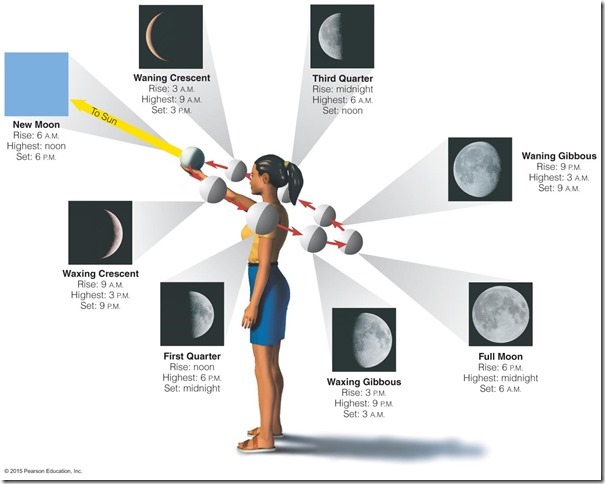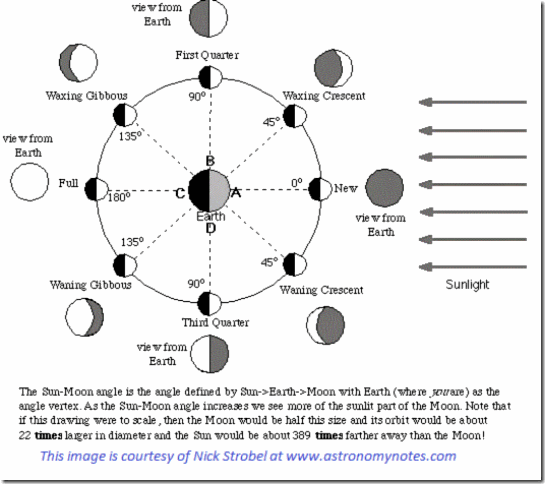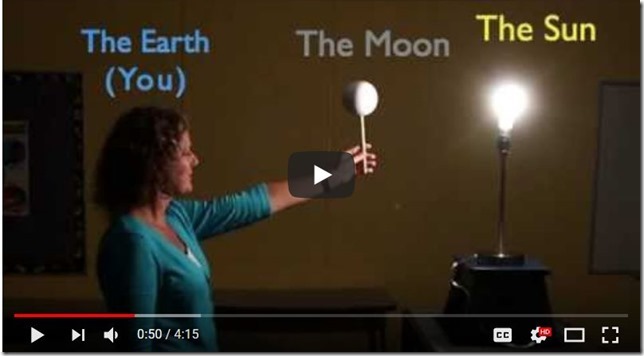(This is a reposting for the Fall, 2018 semester)  I think everyone should learn a bit about the sky, and the motions of the Moon are basic. In fact, if you know the phase of the Moon, you can get a reasonable idea of the time. This may not be overly useful unless you are lost out in the woods without a watch, but it contributes to what famed physicist Richard Feynman called, “The pleasure of finding things out.”
I think everyone should learn a bit about the sky, and the motions of the Moon are basic. In fact, if you know the phase of the Moon, you can get a reasonable idea of the time. This may not be overly useful unless you are lost out in the woods without a watch, but it contributes to what famed physicist Richard Feynman called, “The pleasure of finding things out.”
(The simulated image here shows the correct current lunar phase, courtesy of the United States Naval Observatory )
For instance, if you know what the First Quarter Moon looks like, and you observe it just rising in the East, you could quickly determine the approximate time (roughly noon). Similarly, if you saw the Full Moon just hovering above the western horizon, about to set, you would know that it was just before dawn.
The key understanding is the geometry of the Moon and Sun. When the Moon is directly opposite the Sun in the sky, they are separated by 180 degrees and the phase is full. At First and Third (Last) Quarter phases, the angle between the Moon-Earth-Sun is 90 degrees (actually, 270 degrees for Third Quarter). At the time of the First Quarter Moon, it follows the Sun in the sky; in the case of the Third Quarter Moon, it precedes the Sun.
Here is a good diagram (Fig. 2.21) from page 41 of the 7th edition of your textbook:
Note, for example, when the Moon is between the Sun and Earth, you can draw a line (roughly) from the Sun, through the Moon and on to the observer on Earth. This is a more or less straight line. The Moon would be located in the direction of the Sun and not visible in the glare. It is a “New” Moon. This phase rises and sets with the Sun.
It’s new because it represents the beginning of a new lunar cycle (“moonth”). On the relatively rare occasion when the Sun-Moon-Earth were directly lined up, you could have a solar eclipse, when the Moon appears to pass in front of the Sun.
If you start with a New Moon and move counterclockwise along the orbit, after a week or so you come to what is called First Quarter Moon. In this case if you draw a line from the Moon to the Earth to the Sun, it’s about 90 degrees, a right angle. You see only half the visible surface of the Moon (the half toward the Sun). We call this a quarter Moon because we see only one quarter of the entire surface of the Moon counting the backside, as well as because it represents one quarter of the way through a full lunar orbit. This phase of the Moon rises at roughly noon and sets about midnight.
When the Moon is on the opposite side, opposite the Sun from the Earth (180 degrees from the Sun), the full light of the Sun shines on the half of the Moon facing the Earth and we experience a Full Moon.
Roughly a week later the Moon has moved, still counter clockwise, another 90 degrees around its orbit to the point called Third (or Last) Quarter. It is 270 degrees in the counter clockwise direction around the orbit. But it is only about 90 degrees (a right angle) from the Sun in a clockwise fashion. The difference between this phase and the First Quarter phase is that the opposite side of the Moon is illuminated, and it is in the morning sky, rising at roughly midnight and setting at around noon the following day.
Keep in mind that the Moon is constantly moving around the Earth, and so the phases are constantly changing. As such, there are other phases between these main phases described as crescent and gibbous, waxing and waning. You should learn those, too, but the four main phases are most important.
Test yourself:
1) In which direction is the New Moon at sunset?
2) From Denver, you see the First Quarter Moon due South in the sky. Approximately what time is it?
3) From Denver (Northern Hemisphere), where would you look to see the Full Moon shortly after sunset?
4) John reported observing the Third Quarter Moon at 9 pm. What can you say about this?
Practice these and make up your own. (Answers below)
Also keep in mind that the rough times given here do not consider Daylight Saving Time.
There are some good, short videos linked to the class YouTube page: Astronomy 1040 .
.
Answers:
1) Since the New Moon is very near the Sun, it will be in the western sky at sunset, although too close to the Sun to be seen.
2) As you can see from the graphics, the First Quarter Moon is about 90 degrees to the left (rotating counterclockwise) or East of the Sun. So if the Moon is due South, the Sun must be about 90 degrees to the right (West) as you face South. That puts it on or near the western horizon, so it must be approximately sunset time.
3) The Full Moon is approximately 180 degrees across the sky from the Sun, or opposite the Sun. Therefore if the Sun is setting, the Full Moon will be near the eastern horizon (it may be just above, on or just below the horizon, depending on exact circumstances).
4) John is either mistaken or stuffed absolutely clean full of wild blueberry muffins. The Third Quarter Moon is 270 degrees (counterclockwise) from the Sun, so when the Sun sets, the Moon is still approximately 90 degrees below the horizon. As such, it will not rise until about midnight, and cannot possibly be seen at 9 pm.
